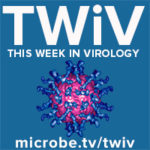
TWiV reviews the appearance of poliovirus in Europe, mystery disease in DRC, global burden of Chikungunya, viruses of parasitic nematodes that induce antibody responses in vertebrate hosts, and picobirnaviruses, do they infect eukaryotes or prokaryotes?
Hosts: Vincent Racaniello, Alan Dove, and Jolene Ramsey
Click arrow to play
Download TWiV 1175 (72 MB .mp3, 120 min)
Subscribe (free): Apple Podcasts, RSS, email
Become a patron of TWiV!
Links for this episode
- ASV 2025 8:12
- Write your senators about RFK Jr 4:40
- Support science education at MicrobeTV
- Poliovirus in Europe (WHO) 9:20
- DRC mystery disease (Reuters) 12:58
- Global burden of chikungunya (BMJ Global Health) 15:48
- RNA viruses of parasitic nematodes (Nat Micro) 21:53
- Picobirnaviruses encode bacterial lysins (PNAS) 1:00:18, 1:08:20
- Prokaryotic ribosome binding site in picobirnavirus genome (Current Opinion in Virology) 1:03:08
- Letters read on TWiV 1175 1:34:19
- Timestamps by Jolene. Thanks!
Weekly Picks 1:47:58
Alan – Sondehub and radiosonde hunting
Jolene – Book “10 to 25: The Science of Motivating Young People” By David Yeager
Vincent – Dr. Vinay Prasad “Sabotaging RFK Jr’s Confirmation Will Increase Vaccine Hesitancy” & “Doctors Criticizing RFK Jr. Paved the Way for His Ascendancy”
Listener Picks
Syl – Foldscope
Jennifer – minutiae
Intro music is by Ronald Jenkees
Send your virology questions and comments to [email protected]
Content in this podcast should not be construed as medical advice.
The post TWiV 1175: A hitchiker’s guide to virology first appeared on This Week in Virology.

As a virologist (by training) recently embarking on the field of gene therapy, I find the graduate program established by Dr. Cattaneo is very interesting, unique, and important. I have raised this issue before here in TWIV and I hope it can be further discussed in more details and the field is in great need for visionary discussion.
From practical and translational perspective, the concepts of combined virology/gene therapy are not well-orchestrated, and more adequate discussion of this topic – mainly by virologists – is not just important but crucial for the advancement of gene therapy field.
Here is a nice example just recently published (last month) in Nature Medicine highlighting how understanding basic virology concepts have marked consequences on the translational application of gene therapy:
Xu Z, Qiu Q, Tian J, Smith JS, Conenello GM, Morita T, Byrnes AP. Coagulation factor X shields adenovirus type 5 from attack by natural antibodies and complement.Nat Med. 2013 Apr;19(4):452-7.
Abstract
Adenovirus type 5 (Ad5) specifically binds coagulation factor X (FX), and FX is normally essential for intravenously injected Ad5 vectors to transduce the liver. We demonstrate that the ability of FX to enhance liver transduction by Ad5 vectors is due to an unexpected ability of FX to protect Ad5 from attack by the classical complement pathway. In vitro, naive mouse serum neutralized Ad5 when FX was blocked from binding Ad5. This neutralization was mediated by natural IgM and the classical complement pathway. In vivo, FX was essential for Ad5 vectors to transduce the livers of wild-type mice, but FX was not required for liver transduction in mice that lack antibodies, C1q or C4. We conclude that Ad5 recruits FX as a defense against complement and that the sensitivity of Ad5 to inactivation by complement must be taken into account when designing vectors for systemic gene therapy.